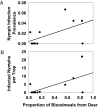Invasive honeysuckle eradication reduces tick-borne disease risk by altering host dynamics
- PMID: 20937859
- PMCID: PMC2973004
- DOI: 10.1073/pnas.1008362107
Invasive honeysuckle eradication reduces tick-borne disease risk by altering host dynamics
Abstract
Despite the ubiquity of invasive organisms and their often deleterious effects on native flora and fauna, the consequences of biological invasions for human health and the ecological mechanisms through which they occur are rarely considered. Here we demonstrate that a widespread invasive shrub in North America, Amur honeysuckle (Lonicera maackii), increases human risk of exposure to ehrlichiosis, an emerging infectious disease caused by bacterial pathogens transmitted by the lone star tick (Amblyomma americanum). Using large-scale observational surveys in natural areas across the St. Louis, Missouri region, we found that white-tailed deer (Odocoileus virginianus), a preeminent tick host and pathogen reservoir, more frequently used areas invaded by honeysuckle. This habitat preference translated into considerably greater numbers of ticks infected with pathogens in honeysuckle-invaded areas relative to adjacent honeysuckle-uninvaded areas. We confirmed this biotic mechanism using an experimental removal of honeysuckle, which caused a decrease in deer activity and infected tick numbers, as well as a proportional shift in the blood meals of ticks away from deer. We conclude that disease risk is likely to be reduced when honeysuckle is eradicated, and suggest that management of biological invasions may help ameliorate the burden of vector-borne diseases on human health.
Conflict of interest statement
The authors declare no conflict of interest.
Figures


References
-
- Wilcove DS, Rothstein D, Dubow J, Phillips A, Losos E. Quantifying threats to imperiled species in the United States. Bioscience. 1998;48:607–615.
-
- Mack MC, D'Antonio CM. Impacts of biological invasions on disturbance regimes. Trends Ecol Evol. 1998;13:195–198. - PubMed
-
- Brooks ML, et al. Effects of invasive alien plants on fire regimes. Bioscience. 2004;54:677–688.
-
- Ehrenfeld JG. Effects of exotic plant invasions on soil nutrient cycling processes. Ecosystems (N Y, Print) 2003;6:503–523.
-
- Bais HP, Weir TL, Perry LG, Gilroy S, Vivanco JM. The role of root exudates in rhizosphere interactions with plants and other organisms. Annu Rev Plant Biol. 2006;57:233–266. - PubMed
Publication types
MeSH terms
LinkOut - more resources
Full Text Sources
Medical

